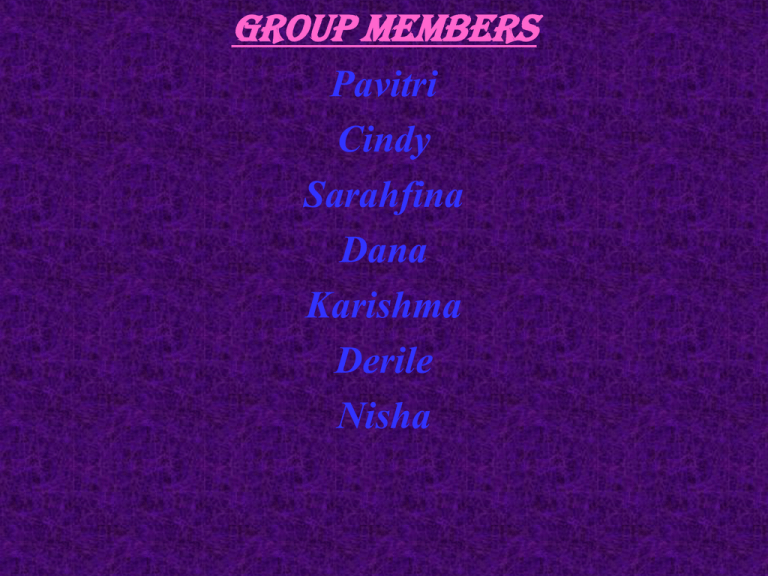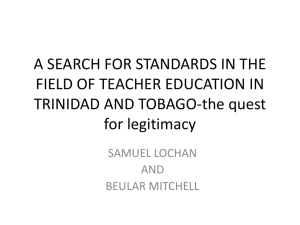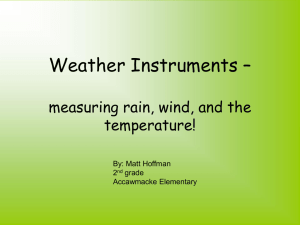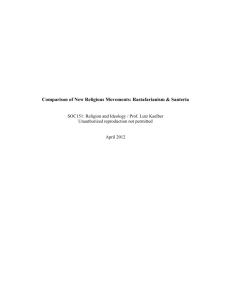Orisha (1)
advertisement

Group Members Pavitri Cindy Sarahfina Dana Karishma Derile Nisha Topic : Orisha Definition Of Orisha : Trinidad Orisha, also known as shango, is a syncretic religion of West Africa and Caribbean origin, influenced by Roman Catholic Christianity What Trinidad Orisha Incorporates Trinidad Orisha incorporates elements of Spiritual Baptism, and the closeness between Orisha and Spiritual Baptism has led to use of the term "Shango Baptist" to refer to members of either or both religions. Anthropologist James Houk described Trinidad Orisha as an "AfroAmerican religious complex, "incorporating elements of West African religion, Catholicism, Protestantism, Hinduism, and Trinidad Kabbalah (an esoteric practice deriving from European mysticism). Trinidad Orisha is derived from West African Yoruba and Dahomean culture, similar to Santeria in Cuba and Candomble in Brazil. Practice of the Trinidad Orisha religion is vibrant in Trinidad and in New York City, where there are significant numbers of Trinidadian immigrants. Trinidad Orisha practices Trinidad Orisha practice involves call and response singing accompanied by a trio of drums. Orisha drums are double-headed bi tensorial cylinders derived from Yoruba bembe drums (similar to the Cuban Iyesá drums). The drum that is lowest in pitch is called the bo or kongo. The lead drum is called "center drum," "big drum," or bembe. The smallest drum, highest in pitch, is called umele. The first two drums are played with a single stick plus hand combination, while the umele is played with a pair of sticks. All of the sticks are curved at the end, and resemble a shepherd's crook. The language of the songs has been referred to as “Trinidad Yoruba” and is derived from the West African Yoruba language. Practitioners of the Yoruba Religion, which was developed among the Yoruba people of Nigeria and Benin, believe that before we are born we stand before God and choose our own destiny. We decide before we ever arrive on earth what we will contribute to the world, where we will live, who we will love, and even the day we will die. However when we are born into the world all of our plans and promises are forgotten and so our destiny in effect becomes to remember and claim the destiny we mapped out for ourselves before our arrival in this life. So who exactly is God? The Yoruba call Him (or more correctly “it” because God is much to all-powerful to be limited by gender) Olódùmarè. The Supreme deity of the Yoruba, Olódùmarè lives in the sky and much like Brahman of Hinduism, is much more respected than He is ever actually approached by worshipers. Olódùmarè is a distant god and when it comes to day to day prayers, things are much more commonly handled by intercessors called Orisha. The seventh annual Rain Festival, organised by Ile Eko Sango/ Osun Mil’osa (IESOM) takes place at the Shrine Gardens, Upper Gasparillo Road (off La Sargesse Road), Santa Cruz, from June 9 to 11. Ile Eko Sango/Osun Mil’osa is a spiritual community comprising Trinidadians and Tobagonians who have come together to reconstruct our spiritual world view, which helps us to come to terms with our divine self and purpose. IESOM meets regularly for worship on its holy days, which is every five, nine, 17 and every 91st day when we celebrate our festivals. IESOM takes an active role in children and adult programmes and as such founded the Osun Abiadama Secondary School in Port-of-Spain. Osun Abiadama is the only Orisha secondary school that teaches Ifa scriptures and African history in T&T. A release from IESOM states, “the Rain Festival brings people together to celebrate rebirth, commitment, understanding and responsibility in a physical and spiritual sense. Observation of the rain cycle will emphasise the importance and sacredness of the rain. “The commencement of the rain cycle is an occasion for reflection, thanksgiving, cleansing and preparation. It also signals the annual cultivation of lands and the inundation of the rivers, which brings the necessary alluvial deposits for riverbanks and seashores among many other things. “The Holy Rain Festival is primarily to ask for the blessings of the deities. The rain is analogous to Sango’s semen; the Earth is considered the womb. The rain or semen impregnates the Earth making it bountiful as it provides water, food, shelter, beauty and happiness. “The earth’s resources contribute immensely to our national well-being and that of the Universe as a whole. We all eagerly look forward to the coming of the rain, but we must also propitiate the deity so we will not suffer some of the experiences of yester year.” The release continues, “the objective of this festival is to sensitise the nation about the environment and how we as citizens are fundamental to its existence. The festival also showcases the spiritual world view and theology of our ancestors and how these are related to the environment for daily survival. “More importantly, over the last six years, this festival has brought together the young people of our nation and the region, of different religious and cultural persuasion in harmony and respect.” Gods Of Orisha










